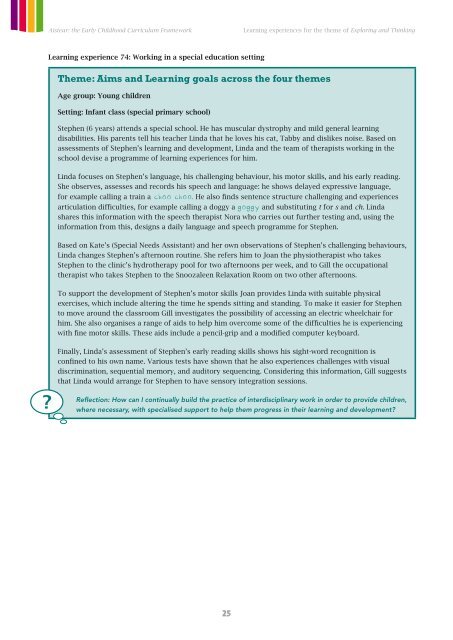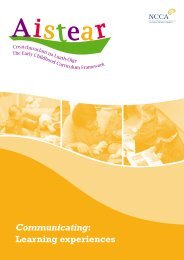Exploring and Thinking: Learning experiences
Exploring and Thinking: Learning experiences
Exploring and Thinking: Learning experiences
Create successful ePaper yourself
Turn your PDF publications into a flip-book with our unique Google optimized e-Paper software.
Aistear: the Early Childhood Curriculum Framework<br />
<strong>Learning</strong> experience 74: Working in a special education setting<br />
25<br />
<strong>Learning</strong> <strong>experiences</strong> for the theme of <strong>Exploring</strong> <strong>and</strong> <strong>Thinking</strong><br />
Theme: Aims <strong>and</strong> <strong>Learning</strong> goals across the four themes<br />
Age group: Young children<br />
Setting: Infant class (special primary school)<br />
Stephen (6 years) attends a special school. He has muscular dystrophy <strong>and</strong> mild general learning<br />
disabilities. His parents tell his teacher Linda that he loves his cat, Tabby <strong>and</strong> dislikes noise. Based on<br />
assessments of Stephen’s learning <strong>and</strong> development, Linda <strong>and</strong> the team of therapists working in the<br />
school devise a programme of learning <strong>experiences</strong> for him.<br />
Linda focuses on Stephen’s language, his challenging behaviour, his motor skills, <strong>and</strong> his early reading.<br />
She observes, assesses <strong>and</strong> records his speech <strong>and</strong> language: he shows delayed expressive language,<br />
for example calling a train a choo choo. He also finds sentence structure challenging <strong>and</strong> <strong>experiences</strong><br />
articulation difficulties, for example calling a doggy a goggy <strong>and</strong> substituting t for s <strong>and</strong> ch. Linda<br />
shares this information with the speech therapist Nora who carries out further testing <strong>and</strong>, using the<br />
information from this, designs a daily language <strong>and</strong> speech programme for Stephen.<br />
Based on Kate’s (Special Needs Assistant) <strong>and</strong> her own observations of Stephen’s challenging behaviours,<br />
Linda changes Stephen’s afternoon routine. She refers him to Joan the physiotherapist who takes<br />
Stephen to the clinic’s hydrotherapy pool for two afternoons per week, <strong>and</strong> to Gill the occupational<br />
therapist who takes Stephen to the Snoozaleen Relaxation Room on two other afternoons.<br />
To support the development of Stephen’s motor skills Joan provides Linda with suitable physical<br />
exercises, which include altering the time he spends sitting <strong>and</strong> st<strong>and</strong>ing. To make it easier for Stephen<br />
to move around the classroom Gill investigates the possibility of accessing an electric wheelchair for<br />
him. She also organises a range of aids to help him overcome some of the difficulties he is experiencing<br />
with fine motor skills. These aids include a pencil-grip <strong>and</strong> a modified computer keyboard.<br />
Finally, Linda’s assessment of Stephen’s early reading skills shows his sight-word recognition is<br />
confined to his own name. Various tests have shown that he also <strong>experiences</strong> challenges with visual<br />
discrimination, sequential memory, <strong>and</strong> auditory sequencing. Considering this information, Gill suggests<br />
that Linda would arrange for Stephen to have sensory integration sessions.<br />
Reflection: How can I continually build the practice of interdisciplinary work in order to provide children,<br />
where necessary, with specialised support to help them progress in their learning <strong>and</strong> development?





